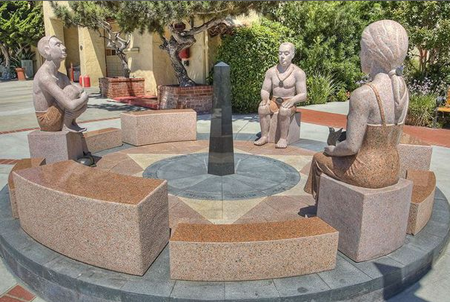Should an arts commission that selects public art projects be comprised of arts professionals with knowledge of public art here and elsewhere?
Should the City Council be allowed veto power over public art projects on aesthetic grounds even if a project is deemed controversial?
Should only local artists be commissioned to create public art in Laguna Beach?

These and other questions surfaced during a presentation on the state of public art in Laguna Beach by Jerry Allen, a representative of the San Diego-based arts consulting firm Cultural Planning Group.
Last week, Allen presented his findings to members of the cultural arts plan steering committee comprised of arts commission member Suzi Chauvel, city council members Kelly Boyd and Robert Zur Schmiede and planning commissioner Susan McClintock Whitin. Zur Schmiede was not present.
Arts commissioner Pat Kollenda told the committee that the city has no clear-cut approach to public art. “Everything we do is site-specific. We really have no mission statement; the city tends to be loath to risk taking,” she said.
Risk taking, according to Allen, can work. He showed Alexander Calder’s “La Grande Vitesse,” a massive red sculpture that the burghers of Grand Rapids, Mich., first rejected and later embraced. “They hated it in the beginning and today it’s an icon. It’s become so much a part of the community’s identity that they turned it into the city logo,” said Allen.
To demonstrate public embrace of public art, Allen showed the once controversial, today iconic Vietnam Memorial, the famed arches of St. Louis, Chris Burden’s “Living Room,” at the Los Angeles County Museum of Art; and the “Rosie the Riveter Memorial,” in Richmond, Calif.

He also touched on the many roles of public art, from aesthetic enhancement to social commentary, from historical markers to entertainment such as “The Broadway Steps” in Seattle. “People stay there and actually try to dance according to the shoe prints in the cement,” said Allen.
What works in the state of cultural arts in Laguna Beach and what doesn’t and how to pull it all together? Those were questions that moved the City Council last year to draft a city-wide cultural arts master plan and hired a consultant to undertake it. A survey seeking residents input is accessible on the city’s website www.lagunabeachcity.net Results have not been tallied since it is still open to participation.
A sampling of local artists who have successfully competed for public arts commissions in Laguna Beach and elsewhere already have some ideas on the topics under discussion.
Sculptor Marlo Bartels said Laguna Beach public art commissions should be open to outside artists. “The arts commission should pick artists on the strength of their past work,” he said. “Our selection process has artists competing against artist during presentations, which is awful,” he said.
“Artists should not have to prepare lengthy presentations into which they have put enormous time and energy and then be rejected. The stipend between $200 and $500 is simply not enough to compensate.”
He added that the arts commission should appoint steering committees versed in public art, including architects, builders and structural engineers. “Committee members selecting public art should be familiar with other city’s programs, such as Boston or Seattle, and study what has been done elsewhere,” he said.
Asked what Laguna could learn from public art programs elsewhere, Marsh Scott said “choosing fewer finalists, giving them more time for their designs and giving more money for them,” she wrote via e-mail.
As for including outside artists into the selection process, she offered a two-tiered solution: “I think smaller commissions should be kept to the close region, with entry level work given to artists living/showing in Laguna. Anything over $100,000 should be from a larger area but with preference given to regional artists. I think a collection that shows the best of the local art community is good for Laguna’s identity as an art colony.”
Scott raised an issue omitted from the presentation: upkeep and maintenance of public art. She thinks the Arts Commission should establish a maintenance program. “Most pieces need inspection, cleaning, waxing, yearly to look their best and last as long as possible. Surrounding lighting and landscaping needs to be maintained as well. Art in public places on private property should be maintained by owners, but the arts commission should work with them as well.”
Sculptor Jon Seeman said he supports a selection process left to professionals. “I would keep the city out of the selection process. The arts commission is qualified to review and artist’s history and potential for success. Commissioners are selected by their qualifications to review and select art. City council member have absolutely no business in pretending to be art critics.”
Photo: “The People’s Council” sculpture outside City Hall draws the disdain of many, but often is the subject of interaction with passersby.
Photo: Jon Seeman’s whale landed in Heisler Park after the City Council rejected it as a potential traffic distraction outside the senior center.





[…] Public art, also a subject of continuing debate among artists, should come under review by professional peers, the report says. Currently, responsibility for reviewing candidates for public art commissions falls to the Arts Commission, political appointees where professional arts training is not mandatory. […]
[…] town’s public art remains a source of continuing debate among artists and the general public. Laguna Beach’s Art in […]